Astronomers have discovered a likely interstellar object — the second after 'Oumuamua — and this one's a comet that will pass nearest the Sun later this year.
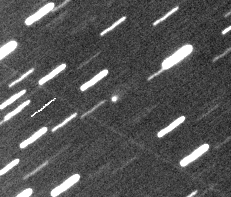
Gennady Borisov
First there was 'Oumuamua, discovered nearly two years ago. Now we might be in store for another interstellar flyby, this time by the recently discovered comet known for now by the provisional designation C/2019 Q4 (Borisov) — formerly gb00234. Gennady Borisov captured the object on August 30, 2019, at the MARGO Observatory near Nauchnij, Crimea when it was about 3 astronomical units (a.u.) from the Sun. Unlike 'Oumuamua, which wasn't spotted until well after perihelion, the new comet is approaching the plane of the solar system and will reach perihelion on December 10, 2019 at a distance of 1.94 a.u.
But it's still early. Don't be surprised if these dates change as more observations come in.
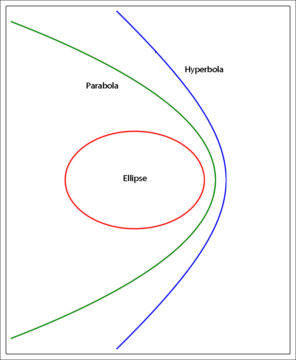
Stamcose / CC BY-SA 4.0 with additions by the author
What sets C/2019 Q4 apart from nearly every other comet is the eccentricity of its orbit. Eccentricity measures how much an orbit deviates from a perfect circle, which has an eccentricity of 0. Elliptical orbits, typical of planets, asteroids and comets, have eccentricities between 0 and 1. Parabolas are equal to 1, and an eccentricity greater than 1 indicates a hyperbolic orbit.
In the few days since its discovery, after which it bore the temporary designation gb00234, observers have broached the possibility of an interstellar origin with caution. The chance of finding it in prediscovery images isn't great, since for some months the comet has been too close to the Sun to have been swept up by wide-field surveys. But it should remain visible for many months before and after it comes closest to Earth in December, and more positional measurements will tighten the orbital fit — and make a stronger case for an interstellar origin.
Meanwhile, images show that the incoming object sports a faint but distinct coma and the barest hint of a tail — something 'Oumuamua lacked — and thus appears to be a comet. Astronomers are no doubt eager to get spectra of the new find to determine what compounds might be escaping from its surface.
Based on current observations, C/2019 Q4's eccentricity is about 3.2 — definitely hyperbolic. Objects on hyperbolic orbits are unbound to the Sun. They're most likely to hail from beyond the solar system, flying in from great distances to pay our neighborhood a brief visit before heading off for parts unknown.
If this result holds up, astronomers have an unprecedented opportunity to study a potentially interstellar object in great detail over a long span of time. Based on the comet's current magnitude (~18) and distance from the Sun (2.7 a.u.), it appears to be a fairly large object — perhaps 10 km or more across, depending on the reflectivity of its surface.
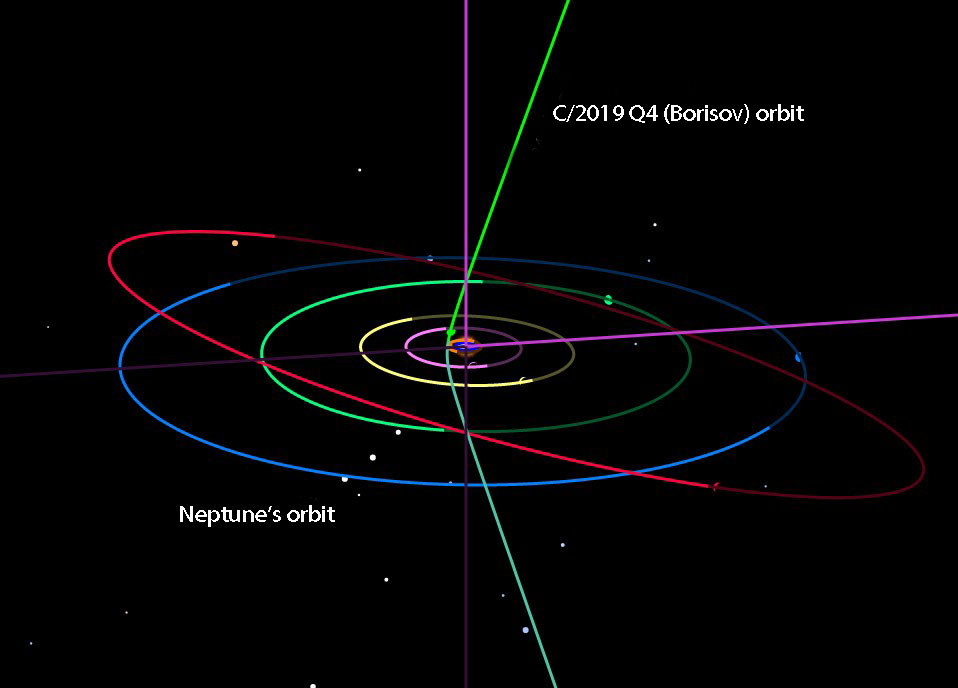
Tony Dunn / CC BY-SA 4.0
Assuming the comet's hyperbolic orbital solution holds, the comet appears to be coming from the direction of the galactic plane in Cassiopeia. Tonight (September 11-12), the object is located about 1° northeast of Iota (ι) Cancri and moving slowly to the southeast.
Whether it becomes visible in amateur telescopes is unknown at this point, but it may become bright enough for astrophotographers to capture. We'll have updates as additional observations and photos arrive. For predicted positions and current orbital element, check out the Minor Planet Center's latest circular MPEC 2019-R106.
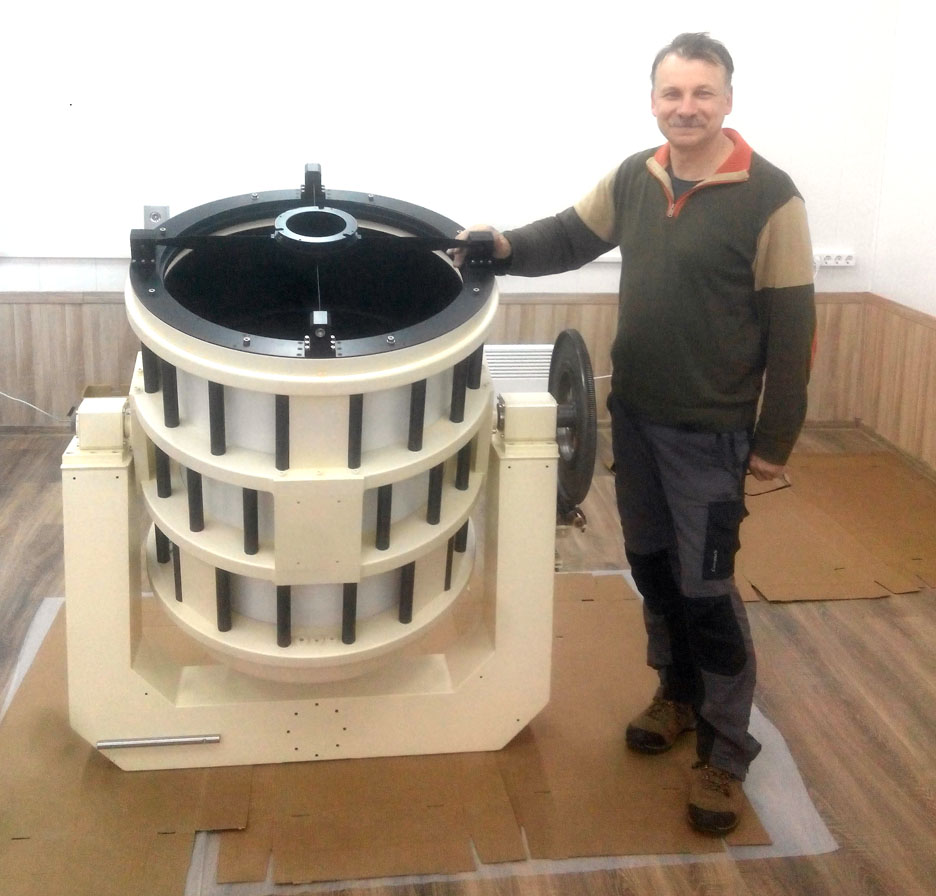
G. Borisov
Here's an amazing fact: The discoverer, Gennady Borisov, is an amateur astronomer who works as an engineer at the Sternberg Astronomical Institute. He makes his own telescopes to hunt for comets and has discovered seven of them along with several NEOs. He recently completed a new 0.65-meter telescope, the instrument he used to discover the new object.
C/2019 Q4 (Borisov) designation will likely remain provisional until the orbit is more secure. The name of the first interstellar object discovered, 1I 'Oumuamua, evolved from C/2017 U1 to A/2017 until finally receiving the I designation for "interstellar." Now that we know it really is a prowler from another star system, it could well become 2I.
According to Bill Gray, the creator of Guide astrometry software, the comet is presently moving at 41 kilometers per second (over 91,000 mph), which will increase to 44 km/sec at perihelion. In the long term — coming toward us from "infinity" and departing for the same — C/2019 Q4 zips along at around 33 km/s. These high velocities, along with the object's hyperbolic orbit, preclude an origin in either the Oort Cloud or due to a close planetary encounter within our own Solar System.
For reference, the average speed of stars relative to the Sun in the solar neighborhood is around 20 km/s. The fact that the comet's relative speed is considerably higher indicates that it's unbound and marching to the beat of its own drum. Gray addresses origin issues for this second interstellar interloper in his excellent FAQ. Well worth a read!
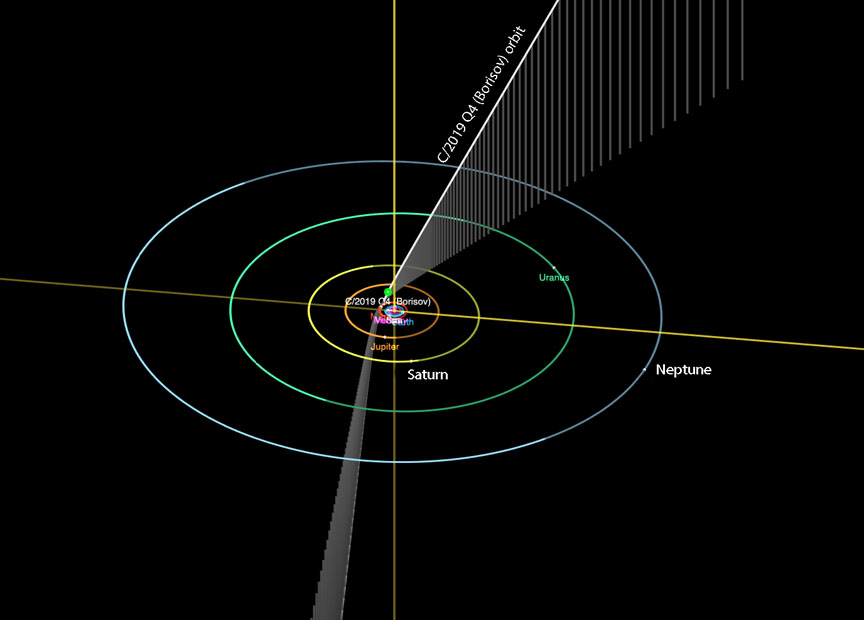
JPL / HORIZONS
At discovery, C/2019 Q4 possessed a moderately condensed coma about 7″ across with a possible 15″ tail to the northwest (P.A. 310°). Additional images from other observers revealed a star-like nucleus, strongly condensed ~15″ coma and confirmed a tail up to 50″ long. It shouldn't be long before amateur astrophotographers have a go at the comet. In mid-October it's expected to crack 16th magnitude and peak at 14.7 around the time of its December 10th perihelion. When brightest the visitor from afar will be in central Crater around declination –20°.
The first 10 days of December will be best for amateur imaging and even visual attempts before the full Moon (Dec. 12) interferes. C/2019 Q4 remains a morning object throughout the current apparition, moving from Cancer through Leo, Sextans, Crater and points south.
 13
13









Comments
Dasmal
September 12, 2019 at 12:30 am
Is it possible that an impact or gravitational encounter in the Oort cloud could change the motion of a comet such that it could begin a steep fall toward the sun, mimicking a hyperbolic origin from outside the solar system?Their motions must be so slow that it might not take much. If whatever orbital motion it had was practically stopped by an encounter, it's approach trajectory extrapolated backward could look very much like an interstellar origin. Perhaps velocity could be used to differentiate whether this could have possibly happened or not, but something falling from the Oort cloud or interstellar space, such that it approaches the inner planet region of solar space, may have practically the same velocity. It would be very unlikely that a body have significant initial velocity and it fall near the sun - most likely initial velocity would keep it much more distant unless it were headed almost directly toward the sun from interstellar space to begin with, which is whu this would be unlikely.
You must be logged in to post a comment.
goodricke1
September 12, 2019 at 12:43 pm
There is simply no way an object falling in from the Oort cloud can reach a velocity of 30km/sec that far from the Sun. Anything with an eccentricity > 3 is interstellar alright.
You must be logged in to post a comment.
Bob KingPost Author
September 12, 2019 at 2:10 pm
Dasmal,
Good question. Goodricke1 is correct. This comet is currently moving at 41 km/sec at the moment, too fast to drop in from the Oort Cloud. Besides, comets that arrive that way almost always track on a parabolic orbit that in truth is really just a very long ellipse.
You must be logged in to post a comment.
Kevin Heider
September 12, 2019 at 9:37 pm
Hyperbolic comets originating from the Oort Cloud will have eccentricities around 1.01. Anything above e=1.5 is obviously interstellar.
You must be logged in to post a comment.
Joe Stieber
September 12, 2019 at 3:30 pm
It may be wishful thinking, but I hope it brightens enough to be seen visually (in my case, with a 16-inch Dob). That would be pretty cool to see an interstellar object with one’s own eyes!
You must be logged in to post a comment.
Bob KingPost Author
September 12, 2019 at 5:08 pm
Joe,
What was the magnitude of the faintest comet you've seen? I've seen down to 14 in my 15-inch. I am hopeful about finding this one especially if it remains strongly condensed.
You must be logged in to post a comment.
Mike
September 13, 2019 at 5:39 pm
thanks for including bill gray's "origin issues" f.a.q. - a lot of good information.
You must be logged in to post a comment.
Scott2112
September 14, 2019 at 8:45 am
Does any of the orbital or velocity information preclude the comet originating in our solar system and becoming interstellar...ie this is a return trip. The existence of these objects will evoke a possible philosophical debate among some and I want to be prepared for the discussion.
You must be logged in to post a comment.
Rod
September 14, 2019 at 9:11 pm
habas2112, the eccentricity is > 3 so the object does not orbit the Sun and velocity near 3 AU is some 41 km^-s, much faster than Mars or asteroids and Jupiter. *possible philosophical debate*, what does this refer to about the comet?
You must be logged in to post a comment.
Harald R
September 17, 2019 at 12:52 pm
Just wonder how did he make his 0,65m f 1.5 telescope. And what kind of camera did he use as I suppose that the second mirror was replaced by a camera. Does the magazine plan to write an article about the design of this telescope?
You must be logged in to post a comment.
Bob KingPost Author
September 18, 2019 at 10:15 am
Hi Harald,
I can't answer those questions, but I did contact Gennady and asked him for you. As soon as he gets back to me I will post it here. As for an article in the magazine I don't know for certain, but it sounds like a good idea.
You must be logged in to post a comment.
Bob KingPost Author
September 20, 2019 at 2:39 pm
Hi again Harald,
I heard back from Gennady. Here is the information you requested. He uses a FLI ML16803 camera located in the direct focus of the telescope.
The FLI Atlas focuser and CCD are mounted on spiders. I hope this will answer your questions.
You must be logged in to post a comment.
Douglas-Jackson
October 1, 2019 at 6:10 am
Hi there, I am in Foxton, New Zealand, with a big enough telescope to see 2I/Borisov, but the comet is not yet far enough south for me to image it! So I have been fascinated but impatient. I am interested in an ephemeris of Borisov that shows if the comet will occult Regulus. The coma comes very close to the 1st magnitude star; does it actually move in front of it from a site on Earth? (or between Hubble and the star!?) Regulus, as a blue-white main sequence star should supply enough light for a good absorption spectrum of the comet's coma to be obtained even with amateur equipment, and we could get lucky and image the nucleus in shadow, with the right wavelengths. But the ephemera I have so far and my knowledge of the coma's size near October 24th (date of the occultation) don't allow me to be sure the event will occur...
Douglas.
You must be logged in to post a comment.
You must be logged in to post a comment.